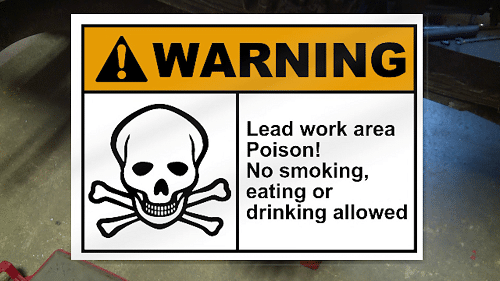Lead Awareness Training – [Complete Video Package]
$239

This Lead Awareness Training will help your employees understand how to deal with lead exposure in the workplace. The dangers of working around lead-containing products and materials are well-known and documented. This OSHA Lead Standard Training is designed to offer employees the training to handle these materials safely and operate in areas that might contain lead.
Lead Awareness Training – Key Concepts Covered:
- Why should employees avoid lead exposure? (It is “toxic” and poisonous to humans, plants, and animals
- What happens if lead is taken into the human body? (It can be fatal, but lead poisoning has other adverse health effects, including high blood pressure, as well as kidney, brain, and reproductive health hazards)
- According to OSHA, how many people are exposed to lead on the job?
- What is the most common way employees are exposed to lead? (The most common workplace exposure occurs when employees breathe in fumes and dust that contain lead)
- What is the route of entry for most lead exposures? (When lead is inhaled, it passes through the lungs and into the bloodstream, where it collects in your tissue and bones)
- What are the two basic categories of lead exposure? (“acute” and “long-term” exposure to lead)
- What are some common symptoms of long-term lead exposure? (A metallic taste, headaches, dizziness, nausea, fatigue, constipation, elevated blood pressure, and loss of appetite are the most prevalent)
Additional Topic Discussed in This Lead Exposure Training:
- What are some common symptoms of acute lead exposure or lead poisoning? (memory loss, tremors, vomiting, and severe stomach pain are the most common)
- What work-related activities might cause an employee to come in contact with lead-containing materials? (Employees who work on car brakes, use smelting or refining, or construction industry workers who sand or strip lead-based paints, to name a few)
- What do the OSHA regulations say about an employer’s responsibility to have a written compliance program for lead?
- What are the three general compliance methods for dealing with lead in the workplace?
- Administrative controls
- Engineering controls
- Personal protective equipment
- What are some examples of policies and procedures that administrative controls might include? (An employee training program, medical surveillance program, housekeeping, and other safe work practices are examples of administrative controls)
- What are some examples of engineering controls? (Physical and mechanical safety features such as ventilation, special vacuums, and isolation and containment of hazardous areas)
Lead Awareness Training Course Discussion Points:
- What are some examples of personal protective equipment that might be used? (Gloves, hats, goggles, respiratory protection, face shields, protective clothing, and overalls meant to protect workers working with or around lead)
- What topics should be included in any lead awareness training program? (The health hazards associated with lead exposure, the OSHA regulations surrounding, and the compliance program of the employer)
- What is the lead threshold exposure limit as defined by OSHA regulations? This is called the “action level,” and it is set at 30 micrograms of lead per meter of air over an eight-hour period)
- What is the OSHA permissible exposure limit or PEL for lead? (The permissible exposure limit for lead is a daily limit of 50 micrograms of lead per cubic meter of air over an 8-hour shift)
Permissible Exposure Limit and Personal Protective Equipment Discussion:
- What is air monitoring, and how is it used?
- What is a respiratory protection program?
- What should employees know about respirator use? (How to properly use and maintain the respirator, what type of respirator filter cartridge to use, and how often the cartridge should be replaced)
- What is a respirator fit test, and why is it important?
- Why compressed air should NOT be used around lead dust or residue
- What PPE is used to combat airborne lead?
More Topics Discussed in This Lead Awareness Training Course:
- When is a medical surveillance program required? (When employees are exposed to lead at or above the action level for more than 30 days per year)
- What is medical removal protection, and what benefits does it have for employees?
- What decontamination procedures should be used to protect workers?
- What is the BLL or blood lead level? You might be subject to temporary medical removal if you have elevated blood lead levels. During your removal, you will receive “medical removal protection benefits.”
- What is the ZPP or zinc protoporphyrin level?
- When are employees required to wear personal protective clothing and equipment?
- What is an employer’s “Initial determination” of lead in the workplace, and why should employees understand this concept?
- What role does medical surveillance program play when it comes to lead hazards?
This lead exposure training course will help your company meet the OSHA regulatory requirements for training employees on lead exposure and lead awareness. Awareness training should be part of a larger safety training program, and employee participation in this training should be mandatory.
Available Delivery Methods for the Lead Awareness Training:
Available in either English or Spanish, the video and written materials are delivered in either DVD or USB Stick format. We also offer an online lead awareness training course if that is preferred. This online lead awareness training can be stand-alone or part of a larger group of safety training courses.
This Complete Lead Awareness Training Program Includes These Items:
- Full-length Lead Awareness Training Video
- Employee quiz and answer sheet
- A “Presenter’s Guide” if you are going to do this training in person
- A printable training sign-in sheet to keep track of your training program
- A printable Certificate of Completion. You can print as many copies of the Certificate as you need
Lead Awareness Training Video – Full-Length Preview:
FAQs on Lead Awareness Training
Answered by our in-house OSHA Authorized Trainer – Jason Hessom

Have a question for us? Give us a call at 800-859-1870 ext 2 or, Contact Us Via Email
Any employer that has the potential for airborne lead exposure shall train their employees at least annually per OSHA 1910.1025(l)(1)(iv).
The Permissible Exposure Limit (PEL) is fifty micrograms of lead per cubic meter of air (50 µg/m3), averaged over an 8-hour work day.
What is a common task that could expose workers to lead?
Welding, demolition operations, scrapers, grinders, or sanders to remove old lead paint can all expose employees to airborne lead.
How do you clean lead dust?
The most common tool to remove lead dust is a High-Efficiency Particulate Air Filter vacuum, also called a “HEPA vacuum.”
Simple blood tests are usually the preferred method.
Does lead dust stay in the air?
Since lead is a heavy metal, the dust won’t stay airborne but will fall to the ground instead.
17 reviews for Lead Awareness Training – [Complete Video Package]
| 5 star | 47% | |
| 4 star | 41% | |
| 3 star | 11% | |
| 2 star | 0% | |
| 1 star | 0% |
![Lead Awareness Training – [Complete Video Package]](https://www.safetyvideos.com/wp-content/uploads/2022/02/products-7-2-150x150.png)







A must for ensuring a safe working environment. Excellent. We liked the quiz too because it confirmed that our employees got what they were supposed to out of the training course.
We can recommend this course it’s good
Good addition to our training library
Good for sure
Helps understand the risks of lead exposure. Essential training for any business that works around lead or the POTENTIAL of lead containing products.